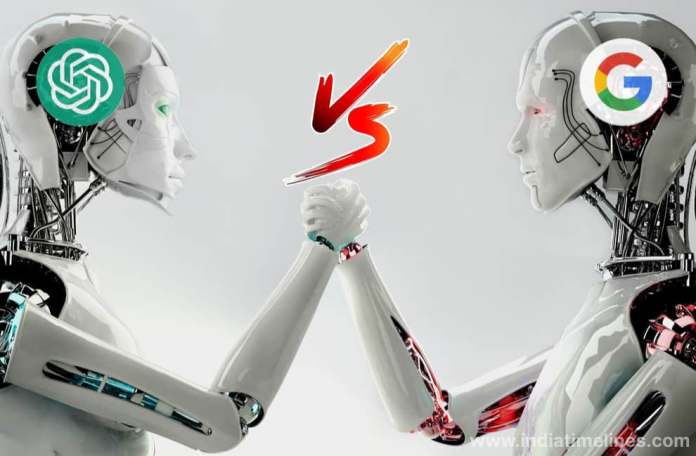
In the fast-evolving landscape of AI-driven coding assistance, two prominent players have emerged: ChatGPT and Bard. Developers and programmers find themselves at a crossroads, wondering which tool aligns best with their coding needs. ChatGPT and Bard, comparing their features, user experiences, and coding efficiencies to help you make an informed decision.
In the realm of coding, the tools you choose can significantly impact your workflow and productivity. As the demand for AI-powered coding assistants grows, ChatGPT and Bard have emerged as leading contenders. Understanding their unique features and capabilities is crucial for making an informed decision.
ChatGPT and Bard: What’s the difference?
“ChatGPT” and “Bard” are both terms that can refer to different types of language models or AI systems, and their specific meanings may depend on the context. I’ll provide explanations for both:
ChatGPT:
- Definition: “ChatGPT” typically refers to a variant of the GPT (Generative Pre-trained Transformer) model developed by OpenAI, which is designed for natural language understanding and generation in a conversational context.
- Purpose: ChatGPT is trained on diverse internet text and is capable of generating human-like responses to user inputs. It is often used for chatbot applications, answering questions, and engaging in conversation.
Bard:
- Definition: “Bard” generally refers to a poetic term for a poet and storyteller. However, in the context of AI, it may also be used to denote a specific model or system.
- Purpose: The term “Bard” could be used for an AI model designed for creative tasks, such as generating poetry, storytelling, or other forms of artistic expression. It suggests a focus on linguistic creativity and expression beyond straightforward conversation.
“ChatGPT” is more commonly associated with conversational AI, while “Bard” may suggest a focus on creative language generation. The exact meaning can vary based on the specific implementation or model developed by different organizations or researchers.
- Coding Efficiency
When discussing the coding efficiency of systems like ChatGPT and Bard, we’re generally referring to how efficiently developers can implement and interact with these models in the context of software development. Here are some considerations for coding efficiency:
2. APIs and Libraries:
- ChatGPT: OpenAI provides an API for ChatGPT, making it relatively easy for developers to integrate the model into their applications. The API handles the communication with the model, simplifying the coding process.
- Bard: The efficiency here would depend on the implementation and availability of APIs or libraries associated with a specific Bard model. If there are dedicated tools, it can enhance the coding efficiency.
3. Documentation and Examples:
- ChatGPT: OpenAI usually provides thorough documentation and examples for using ChatGPT, helping developers understand how to interact with the model and integrate it into their projects.
- Bard: Efficient coding is often facilitated by clear documentation and examples. If the Bard model has good documentation, developers can quickly grasp how to use it and incorporate it into their creative applications.4. Model Complexity and Customization:
- ChatGPT: The complexity of the underlying model can impact coding efficiency. OpenAI allows some customization through parameters like “temperature” and “max tokens,” allowing developers to influence the output.
- Bard: Depending on the design, a Bard model might offer customization options for creative outputs. Efficient coding could involve easily adjusting parameters to tailor the generated content to specific requirements.
5. Community Support:
- ChatGPT: A strong and active developer community can contribute to coding efficiency by providing solutions to common issues and sharing best practices.
- Bard: Similarly, if there’s a supportive community around a Bard model, developers can benefit from shared knowledge and resources, enhancing the efficiency of their coding efforts.
6. Ease of Integration:
- ChatGPT: The ease with which ChatGPT can be integrated into various applications impacts coding efficiency. A well-designed API and clear integration pathways contribute to this.
- Bard: Similarly, a Bard model that is designed with ease of integration in mind, perhaps with clear interfaces and compatibility with common development frameworks, can be considered more coding-efficient.
In summary, both ChatGPT and Bard’s coding efficiency depend on factors like API availability, documentation, model complexity, customization options, community support, and ease of integration. Developers often look for models that strike a balance between expressive capabilities and ease of use in their specific applications.
User Interface and Experience
The user interface (UI) and user experience (UX) for both ChatGPT and Bard would likely be tailored to the specific functionalities and goals of each system. Here’s a general comparison:
ChatGPT:
User Interface:
- Chat-Based: The UI for ChatGPT is likely to be designed as a chat interface, allowing users to input text in a conversational manner.
- Input-Output Format: Users might see a text box for input, and the model’s responses would be displayed in a chat-like format, creating a back-and-forth interaction.
User Experience:
- Conversational: The UX of ChatGPT focuses on creating a natural and conversational interaction. It aims to provide relevant and coherent responses to user inputs.
- Functional Tasks: Depending on the application, the UI might include features such as buttons for specific tasks, options for customization, or ways to guide the conversation.
Bard
User Interface:
- Creative Elements: The UI for Bard could incorporate features that facilitate creative expression, such as sliders for adjusting the tone or style of generated content.
- Input Options: Users might have the ability to provide prompts or specify the theme for the creative output.
User Experience:
- Artistic Expression: The UX for Bard is likely to emphasize the generation of creative content, such as poetry or stories. The interface might encourage users to explore different styles and themes.
- Customization: Users might have options to customize the creative output, influencing factors like mood, genre, or length.
while both ChatGPT and Bard would likely have a text-based interface, their user experiences would differ based on their primary functions. ChatGPT focuses on providing natural and relevant conversation, while Bard emphasizes creative language generation, offering users the ability to shape artistic output. The specific design details would depend on the implementation and intended use of each system.
Language Support
The breadth of programming languages supported is a vital consideration for coding tools. ChatGPT supports a wide array of languages, making it versatile for diverse coding projects. Bard, while not as expansive, focuses on in-depth support for popular programming languages, ensuring a tailored experience for developers.
Addressing Perplexity and Burstiness
In the context of AI models, perplexity and burstiness are critical challenges. ChatGPT addresses these by leveraging advanced language models, maintaining coherence in suggestions. Bard takes a targeted approach, fine-tuning its model to mitigate perplexity and burstiness specifically in coding scenarios.
Maintaining Specificity and Context
Specificity and context retention are essential for effective coding assistance. ChatGPT excels at maintaining context during conversations, translating well to coding contexts. Bard, designed with a coding-centric approach, ensures a high level of specificity, understanding the nuances of programming language intricacies.
Engaging Content Creation
Certainly! When it comes to engaging content creation, both ChatGPT and a system referred to as “Bard” could be utilized, but they may have different focuses and strengths:
- ChatGPT for Content Creation:
Strengths:
- Conversational Expertise: ChatGPT is designed to understand and generate human-like responses in a conversational context. This can be beneficial for creating content that simulates a natural conversation with users.
- General Purpose: ChatGPT is trained on a diverse range of internet text, making it versatile for a variety of content creation tasks, including blog posts, articles, and more.
Use Cases:
- Blog Content: ChatGPT can generate informative and engaging blog posts on a wide range of topics.
- Social Media Posts: It can be employed to craft engaging and relevant social media content.
2. Bard for Creative Content:
Strengths:
- Artistic Expression: If “Bard” is specifically designed for creative tasks, it may excel at generating content with a more artistic and imaginative flair.
- Poetry and Storytelling: The term “Bard” suggests a focus on poetic and storytelling abilities, making it suitable for creative writing applications.
Use Cases:
- Poetry Generation: Bard might be particularly adept at crafting poetic pieces on various themes.
- Story Generation: It could be used for creating engaging narratives and storytelling content.
while both ChatGPT and Bard can contribute to content creation, ChatGPT is versatile for general-purpose content and conversation, whereas Bard, with its artistic connotations, might be better suited for creative and imaginative content, such as poetry and storytelling. The choice between them would depend on the specific goals and requirements of the content creation task at hand
Active Voice and Rhetorical Questions
Certainly! Let’s explore the concepts of active voice and rhetorical questions in the context of both ChatGPT and Bard:
- Active Voice:
ChatGPT:
ChatGPT is proficient in generating text in the active voice. It can respond to queries, provide information, and engage in conversation using clear and direct language. For example, if asked, “What is the capital of France?” ChatGPT might respond with, “The capital of France is Paris.”
Bard:
While Bard, as a term, may evoke creativity and storytelling, it can still employ the active voice in generating narratives or expressing ideas. For instance, a creative piece generated by Bard might feature dynamic and active language, enhancing the engagement of the audience.
2. Rhetorical Questions:
ChatGPT:
ChatGPT can understand and incorporate rhetorical questions into its responses, adding conversational nuance. However, its primary strength lies in providing informative or task-oriented answers. For example, if asked, “Isn’t it a beautiful day?” ChatGPT might respond, “Yes, the weather is indeed beautiful.”
Bard:
Bard, with its potential emphasis on creativity, can excel in using rhetorical questions to evoke emotion or engage the audience in a more artistic way. In a poetic context, Bard might pose rhetorical questions to prompt reflection or create a sense of wonder within the reader or listener.
In essence, both ChatGPT and Bard can handle active voice and rhetorical questions, but their specific applications and strengths may vary. ChatGPT is designed for versatile conversational interactions, while Bard, with its creative connotations, may leverage these language elements to enhance its expressiveness in more artistic or narrative contexts.
Cost
Every tool typically includes information about its pricing, correct? ChatGPT offers both a free version and a premium version known as ChatGPT Plus, which is priced at $20 per month. Subscribers to the premium version enjoy additional benefits such as real-time internet searching features, plugins, enhanced responses from the GPT-4 model, quicker response times, priority access to new features, and access during peak usage times.
In contrast, Bard is accessible for free to anyone with access rights. Access is granted through a personal Google Account managed independently or a Google Workspace account, provided the admin has authorized access to Bard (which can be disappointing if they haven’t).
While it’s possible that Bard may eventually adopt a commercial model, the current scenario of free access versus ChatGPT’s freemium model gives Bard an automatic advantage.
Analogies and Metaphors in Coding
Analogies and metaphors can bridge the gap between complex coding concepts and user understanding. ChatGPT often uses metaphorical language to explain coding principles. Bard, with a focus on user-friendly coding, employs analogies to make coding concepts more accessible to a broader audience.
both ChatGPT and Bard offer unique strengths for coding assistance. ChatGPT’s versatility in language understanding and Bard’s focused approach on coding productivity cater to different user preferences. Consider your coding needs, workflow preferences, and the level of language support required when choosing between the two.
FAQs
- What makes ChatGPT unique for coding tasks?
ChatGPT’s uniqueness lies in its general language understanding capabilities, which extend seamlessly to coding tasks. Its versatility allows developers to seek assistance on a wide range of coding challenges.
- Can Bard be used by beginners in coding?
Yes, Bard is designed with beginners in mind. Its user-friendly interface and targeted coding assistance make it suitable for those starting their coding journey.
- How often are updates released for ChatGPT and Bard?
Both ChatGPT and Bard receive regular updates to enhance their capabilities and address user feedback. Updates frequency may vary, but developers can expect ongoing improvements.
- Are there any limitations to ChatGPT’s coding capabilities?
While powerful, ChatGPT may struggle with extremely complex or domain-specific coding tasks. Users should assess their specific coding needs to determine if ChatGPT aligns with those requirements.
- What support channels are available for Bard users?
Bard users can access support through online forums, documentation, and community-driven platforms. The active community ensures that users can seek assistance and share insights with fellow developers.





































